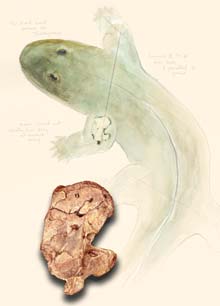New Fossil Links Four-legged Land Animals to Ancient Fish

Sketch depicts limb bone, which bridges the evolutionary gap between fishes and amphibians. <br>Credit: Neil Shubin, University of Chicago
How land-living animals evolved from fish has long been a scientific puzzle. A key missing piece has been knowledge of how the fins of fish transformed into the arms and legs of our ancestors. In this week’s issue of the journal Science, paleontologists Neil Shubin and Michael Coates from the University of Chicago and Ted Daeschler from the Academy of Natural Sciences in Philadelphia, describe a remarkable fossil that bridges the gap between fish and amphibian and provides a glimpse of the structure and function changes from fin to limb.
The fossil, a 365-million-year-old arm bone, or humerus, shares features with primitive fish fins but also has characteristics of a true limb bone. Discovered near a highway roadside in north central Penn., the bone is the earliest of its kind from any limbed animal.
“It has long been understood that the first four-legged creatures on land arose from the lobed-finned fishes in the Devonian Period,” said Rich Lane, director of the National Science Foundation’s (NSF) geology and paleontology program. “Through this work, we’ve learned that fish developed the ability to prop their bodies through modification of their fins, leading to the emergence of tetrapod limbs.”
NSF, the independent federal agency that supports fundamental research and education across all fields of science and engineering, funded the research.
The bone’s structure reveals an animal that had powerful forelimbs, with extensive areas for the attachment of muscles at the shoulder. “The size and extent of these muscles means that the humerus played a significant role in the support and movement of the animal,” reported Shubin. “These muscles would have been important in propping the body up and pushing it off of the ground.”
Interestingly, modern-day fish have smaller versions of the muscles. According to Coates, “When this humerus is compared to those of closely-related fish, it becomes clear that the ability to prop the body is more ancient than we previously thought. This means that many of the features we thought evolved to allow for life on land originally evolved in fish living in aquatic ecosystems.”
The layered rock along the Clinton County, Penn., roadside were deposited by ancient stream systems that flowed during the Devonian Period, about 365 million years ago. Enclosed in the rocks is fossil evidence of an ecosystem teeming with plant and animal life. “We found a number of interesting fossils at the site,” reported Daeschler, who uncovered the fossil in 1993. “But the significance of this specimen went unnoticed for several years because only a small portion of the bone was exposed and most of it lay encased in a brick-sized piece of red sandstone.”
Not until three years ago, when Fred Mullison, the fossil preparator at the Academy of Natural Sciences, excavated the bone from the rock, did the importance of the new specimen become evident.
The work was also funded by a grant from the National Geographic Society.
Media Contact
All latest news from the category: Earth Sciences
Earth Sciences (also referred to as Geosciences), which deals with basic issues surrounding our planet, plays a vital role in the area of energy and raw materials supply.
Earth Sciences comprises subjects such as geology, geography, geological informatics, paleontology, mineralogy, petrography, crystallography, geophysics, geodesy, glaciology, cartography, photogrammetry, meteorology and seismology, early-warning systems, earthquake research and polar research.
Newest articles

High-energy-density aqueous battery based on halogen multi-electron transfer
Traditional non-aqueous lithium-ion batteries have a high energy density, but their safety is compromised due to the flammable organic electrolytes they utilize. Aqueous batteries use water as the solvent for…

First-ever combined heart pump and pig kidney transplant
…gives new hope to patient with terminal illness. Surgeons at NYU Langone Health performed the first-ever combined mechanical heart pump and gene-edited pig kidney transplant surgery in a 54-year-old woman…

Biophysics: Testing how well biomarkers work
LMU researchers have developed a method to determine how reliably target proteins can be labeled using super-resolution fluorescence microscopy. Modern microscopy techniques make it possible to examine the inner workings…





















